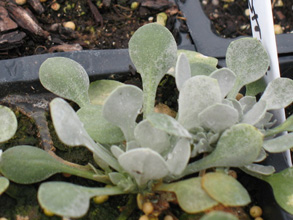Physaria eburniflora in the Landscape

Karen Panter, University of Wyoming
Scientfic Name: Physaria eburnifloraCommon Name: Devil's Gate Twinpod
Description: The species is a member of the Brassicaceae family and is a perennial forb. Silvery-gray foliage. Cream flower heads bloom in early spring.
Native Habitat: Found only in a small area of central Wyoming, Carbon County, at about 7,500 feet elevation.
Cultural Requirement
Soil: Tolerates poor soils, heavy clay in texture.
Moisture Tolerance: Drought tolerant, low moisture levels common in native habitat.
Sun/Shade/Preference: Full sun.
Transplanting: Plants must have well-developed root systems prior to transplanting.
Propagation: Seeds must be fresh. Do not cover seeds as they require light for germination. Seeds require 6 weeks stratification at 40oF. After removal from stratification, place on mist bench or under high humidity. First emergence will occur in about 7 days. Transplant into cell packs or small pots after 5 to 6 weeks.
Maintenance (pruning, fertilization, deadheading, division, irrigation, etc): Requires little irrigation so is suitable for xeriscape or low-water landscapes.
Insect, disease, or other problems: Relatively problem-free.
Landscape Value
Use in the Landscape: Rock gardens and low borders.
Foliage: Beautiful soft, silvery foliage will add winter interest.
Timing: May and June
Color: Creamy white or pale yellow, ½ inch.
Fruit: Less than ½ inch, two-lobed.
Form: Prostrate, flattened rosette.
Texture: Soft, pubescent, silvery foliage.
Ultimate Size: Less than 6 inches tall. Stems prostrate, 3 inches long, flower stalks also prostrate, ½ to 2 inches.
Rate of Growth: Moderate.
Suggested Plant Partners: Rock garden and alpine plants.
Availability: Seeds available through several native plant catalogs, plants very limited.
Cultivars: Not Available.
References:

